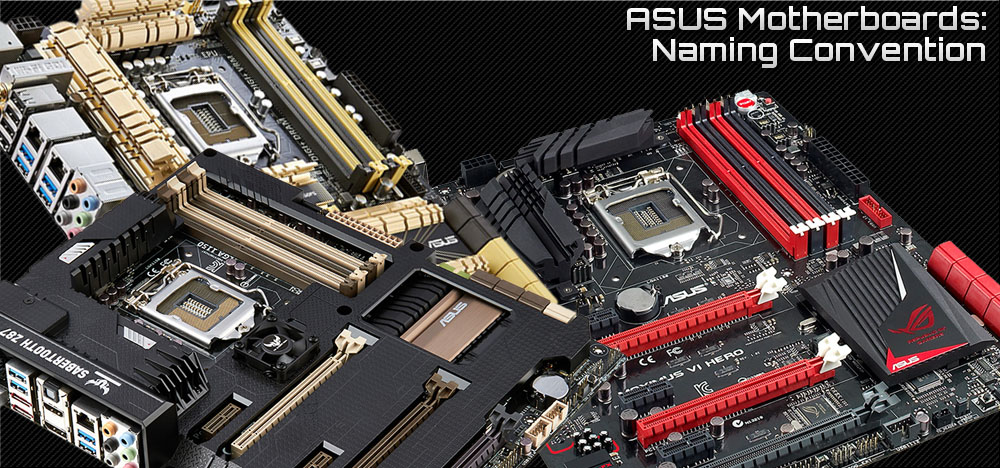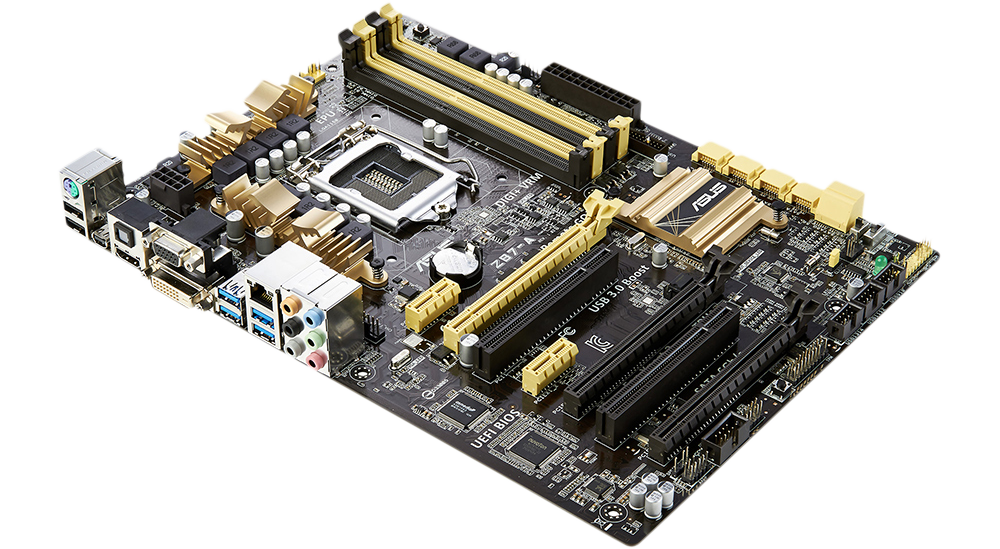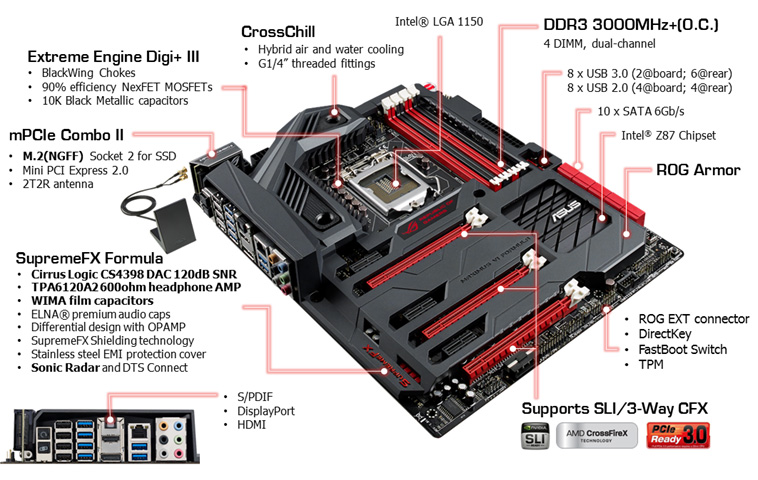We're frequently asked by commenters around the web to help identify model numbers and branding for product lines by each company. Up until last year, ASUS was one of the most requested for such an article. ASUS made major motherboard branding changes in 2013 to simplify their line-up, but we figured we'd get ASUS Technical Marketing Specialist Nick Mijuskovic to give us some finality on their naming convention.
In this quick article (and video component), we'll compare ASUS' motherboard naming scheme and identify the differences between Z87-A vs. Z87-K, Z87-Plus, -Pro, -Deluxe, the TUF boards, and the ROG boards.
The suffixes (Pro, Deluxe, etc.) to ASUS' boards are laddered hierarchically across all chipsets, so while the Z87 boards will host a different chipset than AMD or H8X equivalents, the tiered classification is identical within each chipset. We have further terminology defined under the ROG section.
Here's the rapid-fire version:
ASUS Mainstream Lineup
- Z87-Deluxe
- Z87-Expert
- Z87-Pro
- Z87-Plus
- Z87-A
- Z87-C
- Z87-K
ASUS TUF Mid-Range Lineup
- ASUS Sabertooth
- ASUS Gryphon (mATX)
ASUS ROG (Republic of Gamers
- ASUS ROG Rampage Extreme (LGA2011)
- ASUS ROG Maximus Formula
- ASUS ROG Gene
- ASUS ROG Hero
(All ROG boards are issued in iterations; the current iteration is Maximus VI).
ASUS Z87 Mainstream Motherboard Differences
ASUS' mainstream Z87 lineup consists of the Z87-A, Z87-C, and Z87-K, then the Z87-Deluxe, Z87-Expert, Z87-Pro, and Z87-Plus.
ASUS Z87-A ($140) vs. Z87-K ($118) Motherboards
The -A series of ASUS motherboards have a few key differences over the Z87-K motherboards. The -A board is higher-quality overall and has more features, primarily in the form of better overclocking support (double the chokes in the phase power design) and an overall more advanced VRM. Read more about VRMs and their design here. This is bolstered by an ASUS-proprietary TPU ("TurboV Processing Unit"), which aids in automated overclocking functionality and setup. As an aside, the TPU is totally unrelated to the industry-standard TPM (often located in a similar spot on the board), or Trusted Platform Module, which is designated for biometric and smartcard data storage and security. TPMs are found on some of these boards.
Further, the -A boards are equipped with DTS multi-channel audio support -- if you've got a surround speaker setup and don't have an audio card, this is needed. Other I/O includes 4xUSB3.0 ports (over 2xUSB3.0 on the -K board) and an additional PCI-e 3.0 x16 port compared against the -K board; for this reason, the -A boards are capable of dual x8 video adapter configurations, something the -K boards can't natively do. Other small differences are also present, like overall quality of components and a few troubleshooting features.
The primary difference between Z87-A & Z87-K: The Z87-A board (higher-end) can host an additional video card natively in a 2x8 configuration. Overall component quality is slightly improved.
ASUS' Z87-C ($130) motherboard falls into the middle-of-the-road range that we often find with product branding. As with nearly every in-between product on the market, it just doesn't make the cut for any of our builds. You'll either want to upgrade it to something with better quality or drop it in favor of something more affordable. The Z87-C has a mix of -A and -K features and has generally average user reviews.
ASUS Z87-Deluxe vs. -Expert, Pro, & Plus
ASUS Z87-Deluxe ($287)
The Deluxe, Expert, Pro, and Plus ASUS motherboards are slightly higher-quality than their A-through-K counterparts. This is reflected in the price.
ASUS' Z87-Deluxe board's most defining feature is its 16+2-phase power design. The phase power design dedicates 16 phases purely to cleaning CPU power with an additional 2 phases for memory. ASUS fits a large heatsink atop the MOSFETs on all flanks of the socket, using a standard super-pipe (heatpipe - uses energy phase changing to dissipate heat) to assist in thermal reduction.
South of the processor, we find 2xPCI-e 3.0 x16 (dual-x8 ready) slots and 1xPCI-e 2.0 x4 slot.
For I/O, the Deluxe board also offers the same DTS multichannel audio support as the -A-series board above, which is accompanied by an external wireless antenna (included).
Vs... ASUS Z87-Expert ($230)
All these components are largely the same on ASUS' Z87-Expert board, with the primary exception being that the -Expert motherboard offers an additional Thunderbolt port on the I/O hub. The -Expert board also has half the phases in its power design, operating at 8+2 phases. Finally, ASUS' Z87-Expert, hosts 3xPCI-e 3.0 slots (single x16, dual x8, x8/x4/x4), making it capable of handling three video cards.
The primary difference between the Z87-Deluxe & Z87-Expert: These boards are not immediately comparable. The -Expert is more similar to the Pro and Plus boards, but its support of Thunderbolt boosts the price; this is the biggest difference. Other than Thunderbolt support, an additional PCI-e slot enables more complex GPU configurations.
Vs... ASUS Z87-Pro ($185)
Next in the chain (descending order) is the Z87-Pro. The -Pro board is more comparable to the Z87-Deluxe than it is the Z87-Expert; the -Expert is primarily important for its Thunderbolt option -- other than that, we can forget about it for now.
ASUS' Z87-Pro uses a 12+2 phase power design -- 12 phases for the CPU, 2 for the memory. The same large heatsinks are found here, but with the southern heatsink and super-pipe absent (unnecessary with this design).
The -Pro hosts 2xPCI-e 3.0 ports (x16, 2x8). DTS audio support and a wireless module are also present on this board, as with the Deluxe.
The primary between the Z87-Deluxe & Z87-Pro: The main difference between these boards lives in the form of the phase power design. The -Deluxe board is better equipped for extreme overclocking enthusiasts. If you're not pushing your CPU to absurd voltages and frequencies, you can almost definitely pass on the Deluxe board.
Vs... ASUS Z87-Plus ($160)
Finally, at the bottom of ASUS' mid-range lineup, the Z87-Plus again features an 8+2 phase power design. The heat spreaders are noticeably more discrete and the board components are slightly lower overall quality than the Plus' more bulked-up siblings. No Bluetooth or wireless capabilities are natively available on the board, which is the biggest cost difference between the Plus and Pro boards.
The Z87-Plus hosts 2xPCI-e 3.0 slots (x16 or 2x8). We still have DTS audio support. Fewer SATA III ports are present on the board, but it's largely irrelevant for most users.
The primary difference between Z87-Pro & Z87-Plus: It's the wireless and Bluetooth feature-set that drives the difference here. The board is theoretically slightly less capable of hotter overclocks given the smaller heatsinks, but we haven't officially tested this.
ASUS TUF Lineup: Sabertooth & Gryphon Motherboards
The ASUS TUF line is a step above the mainstream / mid-range suite. ASUS has two TUF boards presently active: The Gryphon and the well-established Sabertooth boards. ASUS' Gryphon is a high-end micro-ATX motherboard whereas the Sabertooth is in the high-end ATX market. They're not necessarily directly comparable as they have different applications. It would be more appropriate to compare the Sabertooth motherboard against the Z87-Deluxe motherboard.
ASUS' "TUF" (The Ultimate Force) family is named for its additional thermal 'armor' and focus on board support. The TUF boards use thick backplates (rear-side of the board) to resist bending/bowing under the strain of multiple GPUs and heavy heatsinks. A good example of a practical application would be Corsair's demo 760T case at CES, where one of our readers pointed out a bent GPU (and pulled/strained PCI-e socket). Using a TUF-class board, the damage caused by heavy components should theoretically be mitigated.
ASUS Z87-Sabertooth ($250)
The Sabertooth boards are part of this TUF family. Outside of core components, the board has a sturdy backplate for strength in supporting large components, with the front-side featuring thermal armor. ASUS' "thermal armor" is used to help direct airflow across the hotter channels along the board. Two motherboard fans live underneath the armor, used to push/pull air across the VRM, PCI-e devices (and, if present, any PCI-e multiplexers), and the chipset.
The Z87-Sabertooth board hosts an 8+2-phase power design, plenty for Haswell chips, and uses "TUF components" in its VRM design. These primarily consist of alloy chokes and Titanium caps / MOSFETs. ASUS claims that these are "certified by military-standard," which tends to be indicative of longer-lasting life and more resilience to extended uptimes. MSI has similar standards for its MPOWER boards.
ASUS' Z87-Sabertooth is capable of outputting 24-bit lossless audio on 8 channels with DTS support. The board has 2xPCI-e 3.0 slots (x16 or 2x8) and 1xPCI-e 2.0 x4 slot.
The primary difference between Z87-Deluxe & Z87-Sabertooth: It's the armor and the VRM design. The Deluxe board has a more complex VRM for extreme overclocks, but the advanced VRM is largely unnecessary for the vast majority of users. The Sabertooth's 8+2 phase VRM is ample for most overclocks. The Sabertooth does not natively host wireless antennae or Bluetooth radios.
ASUS Z87-Gryphon ($163)
And now we arrive at the Gryphon, which was spoiled earlier this year in the lead-up to Haswell's launch.
The Gryphon is technically part of the TUF family, but doesn't ship with the same thermal armor as the Sabertooth and isn't in direct competition with its larger brother. A $45 Thermal Armor Kit is available for the Gryphon, so with a few extra screws and some DIY effort, it can be outfitted with a similar cooling guidance system as the Sabertooth. The Gryphon also uses Titanium capacitors and alloy chokes, as the Sabertooth does.
For an mATX board, it's impressive. The Gryphon has an 8+2-phase power design. It hosts 2xPCI-e 3.0 ports (x16 or 2x8) and 1xPCI-e 2.0 x4 port. 24-bit lossless audio with DTS multichannel support is also on-board.
The primary difference: The Gryphon doesn't directly compare with the other boards here. It's more targeted toward smaller systems that need the build quality traditionally only available on ATX boards.
ASUS ROG Motherboard Comparison
We reach the end of our article. ASUS' flagship line, branded with the known red/black
ASUS' "Maximus" demarcation is indicative of a mainstream chipset on the board (Z87 in the current Intel generation), whereas the "Rampage" line is dedicated to the current Enthusiast-class chipset (X79, theoretically X99 going forward).
Emphasis from ASUS is placed on the fact that these boards aren't necessarily linearly stacked and that each has different applications dependent upon the user (enthusiast overclocking, gaming, entry-level, mid-range). The company classifies its ROG boards below:
- Maximus VI Extreme (enthusiast/overclocking)
- Maximus VI Formula (gaming)
- Maximus VI Hero (entry-level)
- Maximus Gene (micro-ATX)
- Maximus VI Impact (mini-ITX)
A lot of what sets ROG apart is its software packages, but we'll skip past those and focus on the hardware.
ASUS ROG Maximus VI Hero ($190)
The Hero is ASUS' most affordable ROG board at $190. Its primary feature-set includes a focus on high-quality audio components, aiming to emphasize booms and bass -- as found in explosions in games. The audio chip has heavy shielding to minimize impedance.
High-quality chokes (60A BlackWing chokes), dark capacitors (long life), and highly-efficient MOSFETs improve system stability under extreme duress. The VRM uses an 8+2-phase power design.
The Hero offers 2xPCI-e 3.0 slots (x16 or 2x8) and 1xPCI-e 2.0 x16 slot.
Unique BIOS features include a Secure Erase for SSDs -- which we use regularly in SSD testing to restore them to factory settings -- and fully-unlocked overclocking support for all OC-ready components.
The Maximus VI Hero is the most affordable ASUS motherboard of its type on the market, targeting the entry-level ROG crowd. Granted, entry-level ROG is somewhat synonymous with "entry-level enthusiast," given the overall high capabilities of the board when compared against true entry-level motherboards on the market.
ASUS ROG Maximus VI Gene ($210)
With a similar price-point focus to the Hero and similar overall feature-set to the Maximus VI Formula, the Gene ROG board is mostly just a smaller version of the ROG line. It's an mATX board with 8+2-phase power design, high-quality heatsinks, the same high-end board components as the Hero, and 2xPCI-e 3.0 ports (x16 or 2x8) and 1xPCI-e 2.0 x4 port.
Other than that, a lot of the BIOS, software, and on-board components are the same as the Hero. It's a bit smaller and thus has obvious expansion slot limitations that occur on mATX boards.
ASUS ROG Maximus VI Formula ($300)
Here's the flagship of ASUS' Z87 motherboards. Using the thermal armor we described for the Sabertooth above, the Maximus VI Formula is geared heavily toward overclocking support and stability, though isn't as serious about overclocking as the Maximus VI Extreme. Focus for the Maximus VI Formula is placed on "gaming" features, like its high-end on-board audio chipset, boasting a high resistance at 600ohms and SNR (Signal-to-Noise Ratio) output of 120dB.
The Formula can push memory up to 3100MHz with its 8+2-phase power design and implements the same dark capacitors and high-current chokes as found in the previous ROG boards. ROG's Formula implements what ASUS calls a "CrossChill" cooling solution for the VRM components; the heatsink has G1/4-inch threaded fittings for open loop cooling solutions, so if you've got an open loop, it can be directly connected to the VRM cooler. ASUS claims this can achieve temperatures as low as 23C lower than air.
PCI-e support includes 3xPCI-e 3.0 slots (x16, 2x8, x8/x4/x4) for triple-GPU support. A backplate is present to spread the force of three GPUs pulling on the board. An mPCIe socket can be found in the north-west corner of the board (near I/O) for M.2 NGFF notebook form factor SSDs (discussed here).
For I/O, the Formula includes Bluetooth radio transmitters and 802.11ac wireless connectivity. A total of 8xUSB3.0, 8xUSB2.0, and 10xSATA III ports are available.
Key Differences Between the Maximus VI Extreme & Formula
Although the Maximus VI Extreme is more expensive than the Maximus VI Formula, the two have similar market positioning with only a few crucial differences. ASUS notes that "the Formula includes the most features for 'gaming'" but lacks the OC panel that aids in overclock and power monitoring. The Extreme lacks a few features that the Formula has (like the SupremeFX Audio chip we just covered), but this is in favor of appealing more heavily to overclocking enthusiasts by offering other items (like additional monitoring and troubleshooting tools).
Quick Notes on The Rampage (X79) Line
The Rampage line of motherboards has similar branding and terminology to the Maximus VI ROG boards. The boards can be identified as:
- Rampage VI Black Edition (E-ATX top-of-the-line)
- Rampage VI Extreme (enthusiast & overclocking focus)
- Rampage VI Formula (gaming focus)
- Rampage VI Gene (microATX)
Both the Maximus and Rampage versions of the Extreme and Formula motherboards are positioned similarly on the market, but Extreme is priced higher for its added OC and troubleshooting features.
If you've got any questions about motherboard naming conventions, let us know! The same goes for other companies -- they've all got their own thing going on, so this ASUS motherboard round-up should demystify things a bit.
- Steve "Lelldorianx" Burke.





